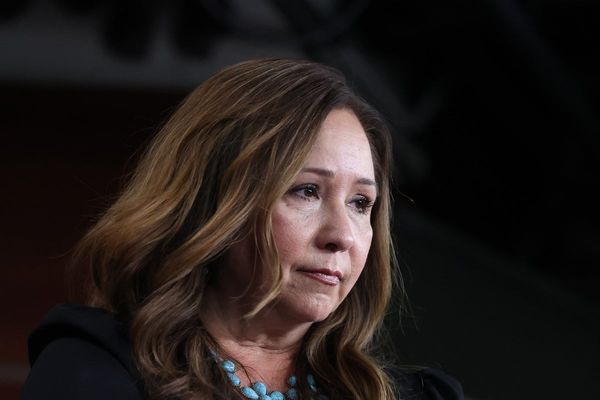
The film-maker Elaine McMillion Sheldon grew up roving around West Virginia. Like many children of Appalachia, her world was shaped by coal – her father worked for a mining company, and the family moved to seven coal fields in 12 years for his job. Her brother became a fourth-generation miner. “Everybody in my community worked in the coal mines,” she said. “If you were going to stay there and work, if you weren’t a doctor or a lawyer, that’s what you did.”
It wasn’t until she studied abroad as an undergraduate and asked people what they did for work that she realized the totalizing extent of coal. “Not everywhere has a king,” said Sheldon. “Not everywhere is completely dominated by this industry that controls everything from our rituals to the ways we live our life.”
Sheldon’s new documentary, King Coal, blooms in the resource’s shadow. It’s a lyrical and visually lush ode to a region of immense richness, to mountains riven by extractive industry, to identity-shaping labor and unions, to the inheritance of coal culture. There are no location markers, no delineation between towns, states, mines, mountains. “We just define it as the kingdom,” said Sheldon, a common culture and economy without strict borders. (She filmed throughout Appalachia, which includes south-western Pennsylvania, eastern Kentucky, all of West Virginia, south-western Virginia, western North Carolina and east Tennessee.) Much has been distorted about Appalachia in the national imagination – as the nation’s spiritless furnace, as the model of sensationalized white poverty, as a looking glass into the “beating heart” of Trumpism. “Maybe you’ve heard a story about us,” Sheldon says in the film. “This story is about what it’s like to live under King Coal.”
“I’m very aware of how people perceive Appalachia,” said Sheldon, now in her 30s and living in Knoxville, Tennessee. That Appalachia is “ugly or depraved”, that its people are uneducated or lacking vision, that it’s all white people, that it’s “a dead end place”. (As a rebuke, the film teems with the sound of crickets, birds, brooks, children, life; we hear a Black family’s lineage of mining stories.) “I grew up feeling that the place I was from was somewhere to be embarrassed of, and I don’t want people to feel that,” said Sheldon. “I want people to see that it’s a beautiful place, that there’s actual hope here and resilience here.”
She wanted a new story, one that would speak to “the psychology of coal, rather than just the economic or environmental side of coal”. So she started by documenting coal culture. Not the mining itself, which appears later in the film – the violent, terribly loud shearing of rock from underground rock, filmed during one shift at a West Virginia mine in 2012 – but the rituals and remnants of the coal economy as the tide goes out. Coal at the center of a town’s new year celebration, a beauty pageant that crowns a “Coal Queen”. A charity race in which volunteers throw faux coal dust on competitors. A history lesson in school, in which a soot-covered former miner recalls near disasters underground. A high school football field built atop a mountain flattened by strip-mining, with players palming a coal pillar for good luck before each game. A museum exhibit extolling the properties of the rock, the product of millions of years and angel-hair layers of plant sediment.
Threading these verité moments together is Sheldon’s elegiac narration, along with scenes that blur the line between documentary and dream. The film follows two young girls Sheldon cast from Appalachia – one white and red-headed, one Black – as they navigate youth under an aged King Coal: school projects and festivals, family stories and oral histories, wonder in the abundant woods. The girls harken to Sheldon’s bygone youth and also point forward, to a life less molded by coal. “Very early on we started thinking about what’s the role of a kid in this space, where they’re also coming of age in this story that’s dying,” said Sheldon. “What is the story they want to tell?”
As Sheldon puts it in the film, coal has been leaving Appalachia for as long as she’s been alive – in barges downriver, in profits reaped elsewhere, in flattened mountaintops and contamination, in lost jobs. “The king isn’t alive today, not like he was,” she says. “But he’s not dead either. I guess you could say he’s a ghost.” The region as a whole lost about 27% of its coal jobs between 2005 and 2015. Promises by the Trump administration to restore mining jobs, rooted in a “return” to the past that underplayed the former power of Appalachia’s mining unions, went unfulfilled. There were just over 22,000 coal mining jobs in Appalachia in 2021, down from its peak of 60,000 a decade prior. Though there have been internal efforts to convert mining jobs to green energy, political and economic leaders have been slow to divest from coal and fossil fuels.
“If you just look at the facts and figures of mining employment, none of this makes any sense,” said Sheldon. “That’s why this film is a film about the psyche and soul of people.” Her many years living in Appalachia taught her that “people just want to work. They’re happy to do other work if it pays the same and provides the same amount of stability, but the coal industry hasn’t provided that stability for many years. And so the question now is, what’s next?”
To begin answering the question, Sheldon staged a symbolic funeral for King Coal, which serves as the film’s conclusion. She invited real people with real connections to mining to send off the resource economy as they saw fit, in song or in prose. “To some people, King Coal is the greedy industrialists, and to some people he’s the person that provided their jobs,” said Sheldon. To Heather Hannah, a singer from Thomas, West Virginia, who offered a gut punch of a coal eulogy, it was “the paradox of pride and remorse. How my daddy was proud to do what needed to be done, to work the mines and provide for our family. I learned that you can be proud of your life, and want better for them that come after you.”
The metaphorical ritual “really paid off”, said Sheldon, “in the sense that it taught me that the act of film-making itself can be impactful for a community. That you don’t have to wait till the film is done and send it out in the world with an educational guide. That this event actually was meaningful to the community because they brought themselves to it.”
Late in the film, Sheldon poses the question hanging over each scene of vivid life and soot-laced barge: will we break the resource curse? It’s not a dilemma she sees for one person or company, nor for one region. “It’s not just Appalachia’s problem,” she said. “This is a story that is relevant today and is one of identity and belonging which we all struggle with. We’re constantly changing.”
King Coal is out in select US cinemas from 11 August with a UK date to be announced







